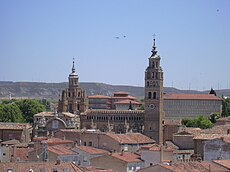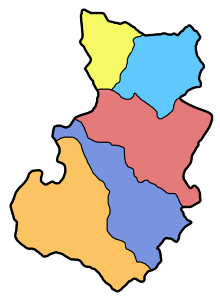Bishop of Tarazona
|
Diocese of Tarazona Dioecesis Turiasonensis Diócesis de Tarazona |
|
|---|---|

|
|
| Location | |
| Country | Spain |
| Ecclesiastical province | Zaragoza |
| Metropolitan | Zaragoza |
| Statistics | |
| Area | 4,514 km2 (1,743 sq mi) |
| Population - Total - Catholics |
(as of 2010) 87,505 74,250 (84.9%) |
| Information | |
| Denomination | Roman Catholic |
| Sui iuris church | Latin Church |
| Rite | Roman Rite |
| Established | 5th Century |
| Cathedral | Cathedral of St Anne in Tarazona |
| Current leadership | |
| Pope | Francis |
| Bishop | Eusebio Hernández Sola |
| Metropolitan Archbishop | Manuel Ureña Pastor |
| Map | |
 Diocese of Tarazona, administrative divisions |
|
| Website | |
| Website of the Diocese | |
The Diocese of Tarazona (Latin, Turiasonensis) is a Roman Catholic bishopric located in north-eastern Spain, in the provinces of Zaragoza, Soria, Navarre and La Rioja, forming part of the autonomous communities of Aragón, Castile-Leon, Navarre and La Rioja. The diocese forms part of the ecclesiastical province of Zaragoza, and is thus suffragan to the Archdiocese of Zaragoza.
The city of Tarazona is situated on a commanding point, surrounded by a beautiful open plain, through which the river Queiles flows.
The Church of the Magdalene was the ancient cathedral, but the Moors, objecting to its prominent position, compelled them to use a church on the outskirts of the town. In the records left by Miguel this was variously called Santa Maria de la Hidria, de la Vega, or de la Huerta, on account of its position. It was endowed by Teresa Cajal, mother of Pedro de Atarés and wife of García Sánchez, and was begun in 1152. Architecturally it is a combination of Byzantine and Gothic, with a high portico entrance and a high brick-trimmed tower. The centre nave with its pointed arches rises above the side aisles and merges into a spacious transept. In the windows Gothic gives place to Plateresque, but in the side chapels dedicated to St. Lawrence, St. Andrew, the Rosary, St. Peter, the Beheading of St. John the Baptist, the Annunciation, St. Elizabeth of Portugal, the Purification and St. James the Great, Gothic prevails in the reredos and tombs. Bishop Moncada attempted to rebuild the beautiful cloister which had been destroyed in the War of the Two Peters, but as late as 1529 this had not been completed.
...
Wikipedia
